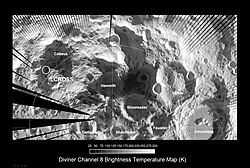Shackleton (crater)

South lunar pole as imaged by the Diviner instrument on the Lunar Reconnaissance Orbiter. Shackleton is at bottom center. NASA photo.
|
|
| Coordinates | 89°54′S 0°00′E / 89.9°S 0.0°ECoordinates: 89°54′S 0°00′E / 89.9°S 0.0°E |
|---|---|
| Diameter | 21.0 km |
| Depth | 4.2 km |
| Colongitude | 0° at sunrise |
| Eponym | Ernest Shackleton |
Shackleton is an impact crater that lies at the south pole of the Moon. The peaks along the crater's rim are exposed to almost continual sunlight, while the interior is perpetually in shadow (a Crater of eternal darkness). The low-temperature interior of this crater functions as a cold trap that may capture and freeze volatiles shed during comet impacts on the Moon. Measurements by the Lunar Prospector spacecraft showed higher than normal amounts of hydrogen within the crater, which may indicate the presence of water ice. The crater is named after Antarctic explorer Ernest Shackleton.
The rotational axis of the Moon lies within Shackleton, only a few kilometers from its center. The crater is 21 km in diameter and 4.2 km deep. From the Earth, it is viewed edge-on in a region of rough, cratered terrain. It is located within the South Pole-Aitken basin on a massif. The rim is slightly raised about the surrounding surface and it has an outer rampart that has been only lightly impacted. No significant craters intersect the rim, and it is sloped about 1.5° toward the direction 50–90° from the Earth. The age of the crater is about 3.6 billion years and it has been in the proximity of the south lunar pole for at least the last two billion years.
Because the orbit of the Moon is tilted only 5° from the ecliptic, the interior of this crater lies in perpetual darkness. Estimates of the area in permanent shadow were obtained from Earth-based radar studies. Peaks along the rim of the crater are almost continually illuminated by sunlight, spending about 80–90% of each lunar orbit exposed to the Sun. Continuously illuminated mountains have been termed peaks of eternal light and have been predicted to exist since the 1900s.
The shadowed portion of the crater was imaged with the Terrain Camera of the Japanese SELENE spacecraft using the illumination of sunlight reflected off the rim. The interior of the crater consists of a symmetrical 30° slope that leads down to a 6.6 km diameter floor. The handful of craters along the interior span no more than a few hundred meters. The bottom is covered by an uneven mound-like feature that is 300 to 400 m thick. The central peak is about 200 m in height.
...
Wikipedia
